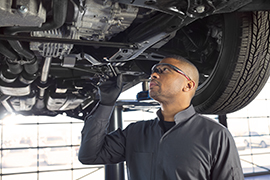Brake Service FAQ
Q: How do I know when I need new brakes?
A: GM Brake pads are equipped with wear indicators that produce a squealing noise when the brakes are almost worn out. The noise may be present with or without the brake pedal applied, but when noise is heard from the wear indicator, the brake pads should be replaced as soon as possible. Wear indicators are set to create noise when there is around 2 mm of brake pad friction material thickness remaining. In the case of assessing pad wear through inspection, pads should be replaced at or before 2 mm thickness is reached.
Rotors should be replaced before they reach this minimum thickness and should not be turned below this.
Q: Must I always turn or replace my rotors when changing my pads?
A: No. If there are no conditions such as pedal pulsation or steering-wheel vibration during braking, and the brake rotor is at least 1 mm thicker than the discard thickness, then it does not need to be turned or replaced.
Q: Do I have to replace my brake rotors after a certain amount of time?
A: No, but it is a good idea to check the condition of your rotors at every tire rotation.
Q: Why does my brake pedal pulse?
A: Brake-pedal pulsation and other conditions such as steering-wheel shaking while braking are caused by thickness variation in the brake rotor when a thicker spot of the rotor rotates through the caliper, it pushes back against brake fluid, which can be felt at the brake pedal. The brake fluid and pedal then relax again as the thick spot exits the caliper. This process produces pedal pulsation and “brake torque variation,” which can shake the steering wheel and seats. Brake pulsation is not caused by warping of the disc. However, distortion of the disc due to excessive temperatures or improper installation and torqueing of the wheels can lead to brake rotor thickness variation over time. Brake-pedal pulsation is corrected by turning and/or replacing the brake rotors to eliminate the thickness variation.
Q: Why do my brakes squeal? How can I stop it?
A: Brake squeal is caused by the high-frequency vibration of brake components (rotor, calipers, and/or pads) in response to excitation from the brake friction process. A significant amount of time and engineering goes into eliminating brake squeal from original equipment brake components. Brake components are engineered as a complete system—factory-original performance can only be assured when using original equipment brake pads and rotors. When brake squeal occurs, there may be damage or excessive wear on one or more components affecting noise, including the brake pads, the noise-damping shim that is bonded to the brake pad, or the rotor friction surface.
In addition, it should be recognized that high-performance and track-capable brake systems using high-performance pad materials may be at higher risk for producing brake squeal noise, even when no damage to the components is present.
Q: How long will my brake pads last?
A: Brake pad life depends on driving habits, vehicle usage, and operating environment. Brake systems are designed to provide 20,000 to 25,000 miles of pad life in very severe use (such as heavy-traffic urban areas) and can give 40,000 to 60,000 miles of pad life in average use. Some factors that will reduce pad life include frequent heavy braking, elevated temperatures (caused by high-speed braking, driving in mountainous areas), driving with the vehicle heavily loaded, and severe environments such as high-corrosion areas and areas with a lot of road debris and dust.
Q: Do metallic brake pads eat rotors?
A: Yes. Pads with higher metal content will tend to operate with more abrasive friction, where hard metal particles in the pad interact directly with the brake rotor surface. Use of metallic pads will create more brake dust and will shorten the rotor life. Non-asbestos organic pads (also known as ceramic pads) used on most GM vehicles in North America develop a transfer film, a layer of material on the pad and rotor surface that acts as a cushion (at a microscopic scale) between the brake pad and rotor, protecting both from abrasive interaction that causes wear.
Q: My brake pads are very dusty. Are all pads dusty?
A: Brake dust can occur to some extent on most brake systems, but it is significantly more noticeable with metallic pads and on high-performance brake systems. Brake dust is a mix of debris from the brake rotor, which is the most significant component, and debris from the brake pads. Pad materials that wear the rotor more aggressively will cause more dust.
Q: Are all brake rotors the same?
A: While brake rotors designed to fit the same vehicle will often be similar in appearance and dimensions, there can be differences in internal cooling vane design, thickness of the brake plates (against which the brake pad rubs), and the grade and material specification of the cast iron. For original equipment brake rotors, significant analysis and testing goes into determining the right geometry to minimize thermal distortion and squeal noise and to maximize cooling. Similar rigor is put into the material selection, which can also affect the risk of squeal noise as well as friction and wear properties.




